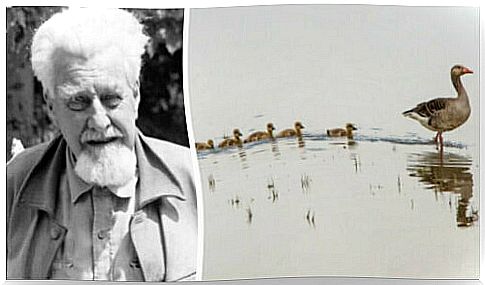Konrad Lorenz And The Behavioral Patterns Of Animals

The Austrian zoologist Konrad Lorenz is considered to be the founder of modern behavioral research. This scientist was a pioneer in the study of animal behavior through comparative zoological methods.
His reflections helped to understand how behavior patterns can be traced back to an evolutionary past. In addition, Konrad Lorenz was also known for his work on the roots of aggression in humans.
In 1973 he and the animal behavior researchers Karl von Frisch and Nikolaas Tinbergen received the Nobel Prize for Medicine.
Family environment and education
Konrad Zacharias Lorenz was born on November 7th, 1903. He grew up both in Vienna and in the family’s summer residence in Altenberg, an Austrian village on the Danube.
He was the youngest son of Adolf Lorenz, a successful orthopedist. His mother was the doctor Emma Lecher Lorenz. From an early age, Konrad liked to have animals and observe them.
Lorenz graduated from one of the best secondary schools in Vienna. His childhood friend Margaret Gebhardt was also interested in animals. The two married in 1939 and had two daughters and a son.
The young Lorenz received his doctorate in medicine (Dr. med.) From the University of Vienna in 1928. In 1935 he was appointed assistant professor at the Anatomical Institute. In addition, he completed a degree in zoology and received his doctorate in this field in 1933, also at the University of Vienna.
Konrad Lorenz died of kidney failure on February 27, 1989 in Altenberg, Germany.
Professional career and successes
Based on the observations he made between 1935 and 1938, Lorenz developed the concept of coinage. Imprinting is the process by which a baby follows an object, usually its biological mother, in its first few months of life.
He came to this point through bird watching (geese and jackdaws). In doing so, he discovered that shortly after hatching, the chicks recognize the sound and appearance of their mother due to their genetic predisposition and can thus establish a permanent bond with her.
He was then appointed professor of psychology at the University of Königsberg in 1940. However, shortly afterwards the Second World War (1939-1945) interrupted his academic career.

War experiences by Konrad Lorenz
Konrad Lorenz served as a doctor in the German Wehrmacht during the war. However, he was captured in 1942 and spent six years as a prisoner of war in the Soviet Union.
Finally he returned to Austria in 1948 and headed the Institute for Comparative Behavioral Research in Altenberg from 1949 to 1951. He then set up a department for comparative behavioral research at the Max Planck Institute in Buldern, Westphalia, in 1950 and was appointed deputy director of the institute in 1954.
From 1961 to 1973 he was director of the Max Planck Institute for Behavioral Physiology in Seewiesen. In 1973, the year in which he also received the Nobel Prize, Lorenz became director of the department for animal sociology at the Institute for Comparative Behavioral Research of the Austrian Academy of Sciences in Altenberg.
Konrad Lorenz’s theses on human aggression

In the last few years of his career, Lorenz applied his findings to the behavior of humans as members of a social species. However, the scientist’s considerations represented a hypothesis with very controversial philosophical and sociological implications.
Because Lorenz argued that fighting and warlike behavior in humans have an innate basis. In addition, he explained that this behavior can be changed by various environmental factors.
In short, Lorenz’s approaches paved the way for a modern scientific understanding of the development of behavioral patterns in a species. In particular with regard to the role of environmental factors and the adaptive value of behavior for species survival.
His research pioneered the concept that animal species are genetically predisposed to learn certain types of information that are important for the species to survive.








